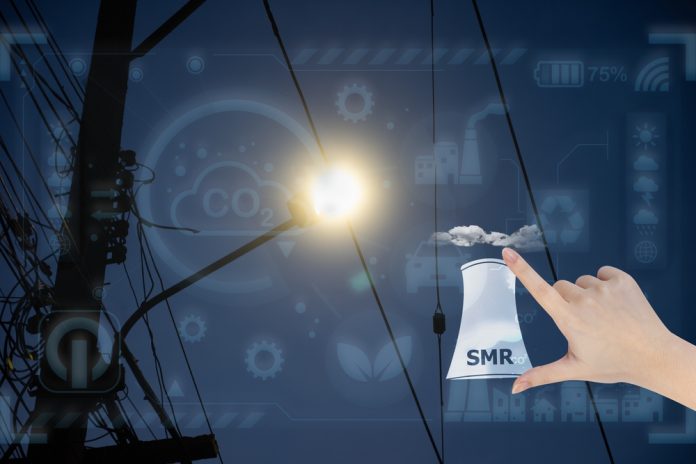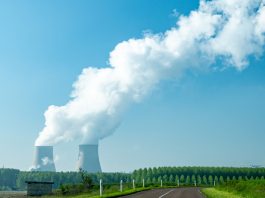The ANItA collaboration at Uppsala University details how small modular reactors are expected to change the perception of nuclear power for good.
The interest in nuclear power as a low-emission and dispatchable energy source has increased significantly in recent years because of the inherent technical problems associated with a large expansion of weather-dependent electricity production.
For example, due to the closure of nuclear reactors, countries such as Sweden and Germany have created an increasingly unstable and fragile electricity system where reduced transmission capacity, increased network costs, and volatile and even negative electricity prices are part of reality today.
So, on what grounds does nuclear power offer a technically attractive solution to these problems?
Let us first establish that all conventional energy sources are based on the forces that hold atoms and molecules together, while nuclear power is based on the forces that hold the atomic nuclei together.
Why nuclear power at all?
Nuclear power forces are much stronger than atomic forces. For example, about 50 million times more energy is released in a nuclear reaction in a reactor fuel than is released in combustion when two oxygen atoms combine with a carbon atom.
This has dramatic consequences. With the possible exception of geothermal energy, nuclear power emits the least carbon dioxide per kWh, which is produced from a life cycle perspective of all the available technologies1.
Nuclear power’s physical footprint per kWh produced is minimal, and therefore, the intrusion into the environment is small. Furthermore, the material flow of concrete, aluminium, and steel is the smallest of all energy technologies2. In addition, nuclear power generates electricity 24-7, and the heavy generators act as efficient stabilisers of the electricity grid. The reactors can also be placed in strategic locations in the power grid, which minimises wiring costs.
Nuclear power thus has several technically attractive properties but also has actual and perceived problems. While the perceived problems are hard to pinpoint because they often involve subjective feelings about nuclear technology, the actual problems can be summed up by the following:
- New large reactors are costly investments, and only a few stakeholders have the financial ability to actually invest in a nuclear reactor. On the other hand, the depreciation period of a reactor is twenty years or so, meaning that the reactor, after this period of time, can generate useful energy for an additional sixty or perhaps even eighty years at a commercially viable price.
- The long-term horizons involved paradoxically pose a problem because they create an incalculable political risk. This risk includes the possibility that uture politics, for example, for ideological reasons, may choose to eliminate the prerequisites for the investment made.
- Management of spent nuclear fuel is a complex undertaking. The problems involved here do not primarily arise from technical considerations but are rather connected to various regulative aspects. The already comprehensive regulations regarding safety, safeguards, and security tend to become even more complex and intrusive over time, which does not necessarily reflect a factual need for such changes.
- The ever-present risk of a major breakdown in any technical system is a problem for nuclear power for three reasons. The first reason is the significant economic loss for the reactor owner. The second reason is that a significant part of the electricity production falls away, which, in turn, negatively affects society. The third reason is that radioactive material risks spreading to the surroundings.
While the first reason is difficult to address, the second can be remedied by building more units to create redundancy. The third can be remedied by installing various mitigation systems that come into play in the event of a major accident, ensuring that the surroundings are essentially unaffected by the event.
Such systems have been retrofitted on all current Generation II reactors in Sweden and are standard equipment in Generation III and III+ reactors.
Standardising small modular reactors
To address large investment costs and to increase the flexibility of nuclear power in the energy system, small modular reactors (SMRs) have gained increased interest. SMRs are a collective name for a spectrum of different technologies where the reactors have an electrical output of typically around 300 MW or less. SMRs may be of the so-called Generation IV type or be based on the same technology as the current large reactors, i.e. using light water as coolant/moderator.
SMRs are intended to be factory-built, either as finished units or in parts, and in both cases, they will be installed on-site. An important part of the SMR concept is that the reactors should be approved by type, unlike today, where each reactor is approved individually.
The fact that SMRs are standardised, have a relatively small physical footprint, are installed rather than built on-site, and have a short estimated implementation time is expected to reduce the capital requirement to a level where current nuclear power companies and new stakeholders such as cities, etc., may take the above-mentioned political risk.
In particular, the idea of standardisation is important, and historical experience confirms the importance of producing reactors with a uniform construction. Sweden, for example, was able to connect twelve rather standardised reactors to the grid within thirteen years. Under such circumstances, the learning curve becomes steep, which is important when implementing any new technology fast and efficiently.
Finally, it can be noted that SMRs have been operating on military ships for around seventy years with good operating experience. Light-water SMRs can, therefore, be thought of as developed versions of military ship reactors that meet civil requirements.
Applications of SMRs
Electricity production
The relatively low output power makes SMRs less suitable for power generation on a national scale than full-scale reactors. However, their size and modular construction make them excellent for local or regional power generation, for example, producing electricity for larger communities and industrial complexes.
They are also well suited for reinforcing and stabilising the national electricity grid where needed, although the economic implications for this application are currently unclear.
In countries that lack an extensive national electricity grid, SMRs can be an efficient solution to the electricity shortages these countries often suffer from. In operation, SMRs are also not expected to require a large workforce, which also suggests that the concept can benefit the currently poor part of the world.
Production beyond electricity
Besides the advantages mentioned above, the strength of SMRs lies in applications that currently lack environmentally and climate-friendly solutions. Examples of such applications are district heating, desalination of seawater, heating of greenhouses, process steam and hydrogen production.
The ANItA collaboration has comprehensively studied how SMRs can be used in various applications. For example, this paper offers a brief account of the subject3.
Safety and security of SMRs
Some technical features of SMRs are based on simple physical principles. This allows for a high safety level to be achieved because the safety systems can be made ‘passive’, meaning that no human intervention or external power is necessary to make them operate.
For example, the relatively small size of the reactor cores allows for the design of the reactor vessel, such as enabling cooling of decay heat in a shut-downed reactor by using self-circulation of the coolant. In addition, such a system can be made simple with a minimum need for valves and other elements that may fail.
Overall, this drastically reduces the risk of core meltdown, as no external power or handling is required to operate the coolant pumps. Here, it should be noted that passive systems are add-ons to already very safe constructions based on long-term experience from nuclear power design and utilisation4.
For some applications, SMRs can be expected to be part of distributed systems with many units. While this offers opportunities to create redundancy in the energy supply, it also creates challenges. One such challenge is the management of nuclear material. Today’s non-proliferation regime includes nuclear safeguards as an important tool for the world community to be able to determine that all nuclear material is located where it is supposed to be and has the declared properties.
However, the current safeguards are developed to handle a country’s relatively small number of full-scale reactors and logistics and storage are well-defined and manageable from a safeguards point of view.
When many SMRs are introduced on non-traditional nuclear sites, things become more complex. For example, new transport routes for fresh and spent fuel will be required, and with these, a more extensive implementation of safeguards will be required. In general, logistics will become more diversified and more difficult to monitor in a comprehensive way.
Because current nuclear safeguards are not well adapted to such a new reality, novel approaches must be developed. This, in turn, will require close cooperation between regulators, industry, academia, and the International Atomic Energy Agency (IAEA). Such development work is ongoing within the ANItA collaboration5.
Finally, it is worth noting that for land-based use, the size of SMRs allows them to be installed underground or in rock caverns, reducing their exposure to external influences and thus augmenting their security.
Summary
In a fully implemented stage, small modular reactors are expected to offer economically viable solutions for small to medium-scale applications. This circumstance makes the technology suitable for smaller stakeholders, such as cities, companies, and others who need local or regional production of useful energy.
The safety of the various SMR concepts currently under scrutiny is designed to fulfil the strictest requirements possible. One important safety feature is the ability to cool the core after shutdown by using self-circulation if needed.
While the electricity production of a typical SMR is substantially smaller than a full-scale reactor, SMRs exhibit several advantages important for various applications beyond electricity production, including:
- The relatively small sizes make it possible to deploy SMRs in locations where full-scale reactors simply do not physically fit. Such locations can be in proximity to cities and factory areas.
- The combination of heat and electricity makes SMRs of interest for combined district heating and electricity production, therefore improving the economy when the reactors are operated in load-following mode.
- While the electric output is smaller than full-scale eactors, a 300 MW generator is by no means small in terms of inertia. This means that SMRs are suitable for stabilising the grid at strategically chosen points.
- On a fundamental level, light-water SMRs represent no new technology. Besides the passive safety systems, the operation and maintenance scheme will be downsized versions of the ones used for the current light-water reactors. This is advantageous because the existing know-how and logistics can be used to a large extent. However, the anticipated new applications will pose some new challenges regarding regulatory issues, safeguards and security, and these aspects must be properly addressed.
References
- https://group.vattenfall.com/siteassets/corporate/who-we-are/sustainability/doc/life-cycle-assessments-for-vattenfalls-electricity-generation_2023.pdf
- See e.g. “Projected material requirements for the global electricity infrastructure – generation, transmission and storage”, S. Deetman et al., Resources, Conservation & Recycling, 164 (2021) 105200
- https://www.uu.se/download/18.547e7b518eeffced3d71e9/1713515478959/c_1062422-l_3-k_anita-a1-rapport-1.pdf
- https://www.innovationnewsnetwork.com/smr-designs-suitable-for-swedens-future-electricity-production-needs/49733/
- ANItA – Uppsala University (uu.se)








